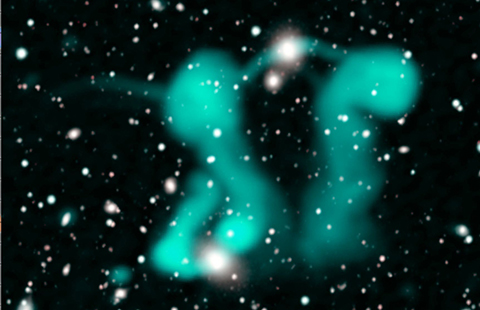
Researchers from Western Sydney University and CSIRO, Australia’s national science agency, have discovered strange clouds of electrons surrounding galaxies deep in the cosmos. The clouds, which are about a billion light years away and never been seen before, resemble two ghosts dancing.
The ‘dancing ghosts’ were discovered as part of the first deep sky search using CSIRO’s ASKAP (Australian Square Kilometre Array Pathfinder) radio telescope.
The discovery – in a paper accepted this week in Publications of the Astronomical Society of Australia ( PASA) describing the first Pilot Survey of the EMU (Evolutionary Map of the Universe) project – is one of several objects and phenomena uncovered in the deep search according to lead researcher Professor Ray Norris from Western Sydney University and CSIRO.
“We are getting used to surprises as we scan the skies as part of the EMU Project, and probe deeper into the Universe than any previous telescope. When you boldly go where no telescope has gone before, you are likely to make new discoveries.
“When we first saw the ‘dancing ghosts’ we had no idea what they were. After weeks of work, we figured out we were seeing two ‘host’ galaxies, about a billion light years away. In their centres are two supermassive black holes, squirting out jets of electrons that are then bent into grotesque shapes by an intergalactic wind.
“New discoveries however always raise new questions and this one is no different. We still don’t know where the wind is coming from? Why it is so tangled? And what is causing the streams of radio emission? It will probably take many more observations and modelling before we understand any of these things,” said Professor Norris.
Other objects and phenomena uncovered so far as part of the EMU Project include the discovery of the mysterious Odd Radio Circles (ORCs) which seem to be giant rings of radio emission nearly a million light years across, surrounding distant galaxies.
“We are even finding surprises in places we thought we understood. Next door to the well-studied galaxy IC5063, we found a giant radio galaxy, one of the largest known, whose existence had never even been suspected. Its supermassive black hole is generating jets of electrons nearly 5 million light years long. ASKAP is the only telescope in the world that can see the total extent of this faint emission,” said Professor Norris.
The ASKAP telescope is operated by the CSIRO and forms part of the Australia Telescope National Facility. It uses novel technology to achieve extremely high survey speed, making it one of the best instruments in the world for mapping the sky at radio wavelengths.
EMU is an international team of more than 400 researchers led by Professor Andrew Hopkins of Macquarie University. The EMU Pilot Survey is led by former EMU project leader, Professor Ray Norris from Western Sydney University.
We acknowledge the Wajarri Yamatji as the traditional owners of the Murchison Radio-astronomy Observatory site, on which ASKAP is located.
Access EMU to explore the sky via emu-survey.org. Zoom in from the big picture down to the finest details, and see what you find.








